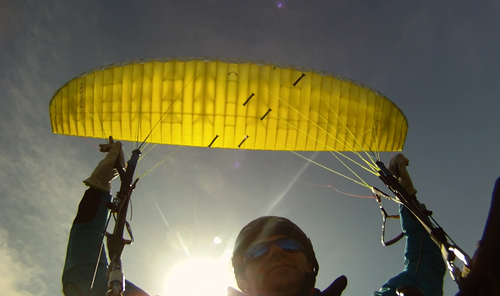Alpha 5 26 |
|||||||||||||||||||||||||||||||||||||||||||||||||||||||||||||||||||||||||||||||||||||||||||||||||||||||||||||||||||


|
|||||||||||||||||||||||||||||||||||||||||||||||||||||||||||||||||||||||||||||||||||||||||||||||||||||||||||||||||||
Instability rating |
|||||||||||||||||||||||||||||||||||||||||||||||||||||||||||||||||||||||||||||||||||||||||||||||||||||||||||||||||||
|
|||||||||||||||||||||||||||||||||||||||||||||||||||||||||||||||||||||||||||||||||||||||||||||||||||||||||||||||||||
Glider characteristics |
|||||||||||||||||||||||||||||||||||||||||||||||||||||||||||||||||||||||||||||||||||||||||||||||||||||||||||||||||||
|
Launch preparations: easy
launch characteristics: balanced, climbs constantly, no guidance necessary, good feedback during inflation, little braking required, control check simple, low takeoff speed
asymmetric collapse: canopy colllapses at high angle to leading edge, en: EinklapperDynamikGering, total course change 90-180°, (1), moderate course change rate, moderate forward pitching 45-60°, (2), moderate height loss 30-39 m, (2), moderate sink velocity 15-19 m/s, (2), G-Force < 2,5 G, (1)
Frontal collapse: canopy collapses with high total collapse aera, moderate pitch backwards 30-45°, moderate pitch forwards 30-45°, moderate dynamics, no course change, (1), delayed recovery, symmetric recovery, delayed return to normal airspeed, short deep stall phase, high height loss 40-49 m, (3), low sink velocity 10-14 m/s, (1)
Spiral dives: moderate sink velocity increase, Moderate G-Force 3,5- 4.0 G, (2), Sink velocity after 720° <14 m/s, (1), Moderate maximum sink velocity < 18 m/s, (2), sink velocity increase < 6 m/s on brake release, (2), Course change 90-180° after spiral exit, (1), moderate height loss during recovery 30-60 m, (2)
B-Stall: high force required, marked pitch backwards 30-45°, moderate pitch forwards 15-30°, stable sink phase, no tendency to deform, immediate return to normal airspeed, 6-8 m/s, height loss on recovery < 20 m
big ears: simple initiation, stable flight phase, immediate automatic recovery, Vsink unaccelerated 2,5-3 m/s, Vsink accelerated 3,5-4 m/s, Vunaccelerated 0-3 km/h less than trimspeed, Vaccelerated 0-3 km/h faster than trimspeed |
|||||||||||||||||||||||||||||||||||||||||||||||||||||||||||||||||||||||||||||||||||||||||||||||||||||||||||||||||||
Notes |
|||||||||||||||||||||||||||||||||||||||||||||||||||||||||||||||||||||||||||||||||||||||||||||||||||||||||||||||||||
|
Launch Characteristic: All 3 LTF-A gliders behaved excellently, smooth inflation and good feedback via the pressure on the A-risers as the canopy climbed to the zenith. Aside from the Alpha 5 which needed a little more brake, all canopies could then be easily stabilized over the pilot with normal brake appliance. Asymmetric Collapse: The Alpha 5/26 demonstrated typical behavior for their respective LTF classes. Front Collapse: Demonstrated excellent characteristics after front collapse tests. Recovery after massive front collapses with no delay and little height loss. The Alpha 5 and need a few seconds more to return to normal flight. Spiral Dive: The Alpha 5 demonstrated well balanced behavior while spiralling. These gliders accelerate and increase sink rates moderately. B-Stall: High entry force, very stable sink phase. Big Ears: No glider showed a tendency to oscillate during the manoeuvre, and brake appliance to exit from the manoeuvre was not required. All gliders exited without pilot input. |
|||||||||||||||||||||||||||||||||||||||||||||||||||||||||||||||||||||||||||||||||||||||||||||||||||||||||||||||||||
Rating |
|||||||||||||||||||||||||||||||||||||||||||||||||||||||||||||||||||||||||||||||||||||||||||||||||||||||||||||||||||
|
Safety class 3 This class of paraglider react moderately to one or more of the following manoeuvres: frontal collapse, asymmetric collapse or spiral dive.Moderately means that the above manoeuvres result in dynamic reactions from the glider and/or large height losses. Good piloting skills which need to be regularly practised, together with good personal reaction times which are above basic training levels are required to safely fly this class of gliders. Skill and experience levels greater than those attained in basic training are required to safely recover from the above manoeuvres. Emergency descent manoeuvres, in particular spiral dives may require advanced recovery skills. Additional training such as regular ground handling or SIV training is recommended. |
|||||||||||||||||||||||||||||||||||||||||||||||||||||||||||||||||||||||||||||||||||||||||||||||||||||||||||||||||||

